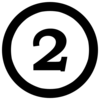| VideoWiki/Major depressive disorder (Tutorial) | |
|---|---|
| Link to Commons | |
| Steps for video creation | |
| Step 1 | Preview my changes (10 sec) |
| Step 2 | Upload to Commons (10 min) |
Overview
Major depressive disorder (MDD), also known simply as depression, is a mental disorder, characterized by at least two weeks of low mood, that is present across most situations.[1]

Symptoms
It is often usually accompanied by low self-esteem, loss of interest in normally enjoyable activities, low energy, and pain without a clear cause.[1]

Other symptoms
People may also occasionally have false beliefs, or see or hear things that others cannot.[1] Some people may have periods of depression, separated by years in which they are normal, while others nearly always feel its effects.[2]

Effects
Major depressive disorder can negatively affect a person's personal life, work life, or education, as well as sleeping, eating habits, and general health.[1][2]

Suicide
Between 2–8% of adults with major depression die by suicide,[3][4], and about 50% of people who die by suicide had depression, or another mood disorder.[5]

Cause
Depression is believed to be cause by a combination of genetic, environmental, and psychological factors.[1]

Diathesis-stress model
One theory, is the diathesis–stress model. It theorizes, that depression occurs when someone has a preexisting vulnerability (such as an inherited link to depression) that is activated by stressful life events.[6]

Risk factors
Risk factors include, a family history of the condition, major life changes, certain medications, chronic health problems, and substance abuse.[1][2]

Genetics
About 40% of the risk appears to be related to genetics.[2]

Diagnosis
The diagnosis of major depressive disorder, is based on the person's reported experiences, and a mental status examination.[7]

Testing
There is no laboratory test for major depression.[2] Testing however, may be done to rule out physical conditions that can cause similar symptoms.[7] Major depression is more severe, and lasts longer than sadness, which is a normal part of life.[2]

Screening
Some have recommended screening for depression, in people over 12 years old,[8][9], but a Cochrane review found that the routine use of screening questionnaires, has little effect on detection or treatment.[10]

Treatment
Depression is treatable, as long as it's recognized. The three most common treatments for depression, are psychotherapy, medication, and electroconvulsive therapy, in combination with lifestyle changes. Psychotherapy is the treatment of choice for people under 18[11].

Mild depression
Even for people over 18, it is recommended that antidepressants should not be used for the initial treatment of mild depression, because the risks, often out-weigh the benefits.[12].

Exercise and counselling
Instead, increasing exercise[13], smoking cessation,[14] and counseling, such as cognitive behavioral therapy and interpersonal therapy, are advised.[1][15].

Medication
Recommendations are that antidepressants, in combination with psychosocial counselling, should be reserved for the following situations;

Medication1
people with a history of moderate, or severe depression,

Medication2
those with mild depression that has been present for a long period,

Medication3
as a second line treatment for mild depression that persists after other interventions,

Medication4
or as a first line treatment for moderate or severe depression.

Medication limitations
Medication can be effective, but the effect may only be significant in the most severely depressed.[16][17] It is unclear whether medications affect the risk of suicide.[18]

ECT and hospitalization
If other measures are not effective, electroconvulsive therapy (ECT) may be considered.[1] Hospitalization may also be necessary, especially when a person is at risk of hurting themselves, even if it is against their wishes.[19]

Epidemiology
Major depressive disorder affected approximately 3% of the world's population in 2015,[20] with as many as 21% affected at one point in their life.[21]

Age and gender
The most common time of onset, is in a person's 20s and 30s.[2][21] Females are affected about twice as often as males.[2][21]

History
Historically, depression was called melancholy, and even the 16th American president Abraham Lincoln, suffered from a condition that now may be referred to as clinical depression.[22]
